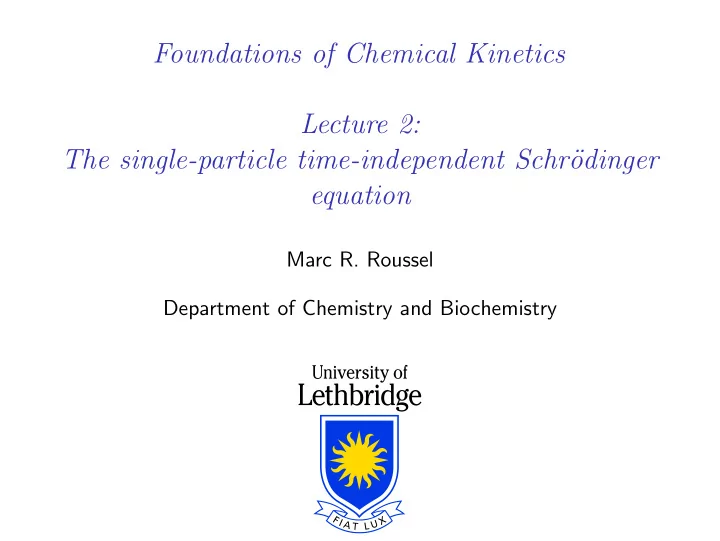

Foundations of Chemical Kinetics Lecture 2: The single-particle time-independent Schr¨ odinger equation Marc R. Roussel Department of Chemistry and Biochemistry
Quantum mechanics of single particles ◮ De Broglie’s theoretical arguments (1924) and their experimental verification by Davisson and Germer (1927) showed that particles have wave properties. ◮ Debye commented after a presentation by Schr¨ odinger on de Broglie’s work at a seminar in Zurich in the Fall of 1925 that, if particles behaved like waves, they should have a wave equation. ◮ That wave equation was provided by Schr¨ odinger a few months later. ◮ Born (1926) proposed that the wavefunction was connected to probability.
The wavefunction ◮ For a single particle, the wavefunction, ψ , is a function of the spatial coordinates, i.e. ψ = ψ ( x , y , z ). ◮ In general, the wavefunction may be complex-valued, i.e. it has real and imaginary parts. However, in many simple cases, we can get away with real-valued wavefunctions. ◮ The square of the wavefunction is a probability density, i.e. ◮ | ψ ( x , y , z ) | 2 is the probability of locating a particle near the coordinates ( x , y , z ) per unit volume; or ◮ | ψ ( x , y , z ) | 2 dx dy dz is the probability that the particle will be found in a volume of dimensions dx × dy × dz centered on the coordinates ( x , y , z ); or R | ψ ( x , y , z ) | 2 dx dy dz is the probability that the particle ◮ � � � will be found in the region R .
The wavefunction and particle positions ◮ The wavefunction contains all the information that can be known about a particle. ◮ Particles do not have precise positions in quantum mechanics. ◮ A measurement of the position ◮ is limited in precision by the uncertainty principle; and ◮ “localizes” the particle through wavefunction collapse (transformation of the wavefunction to a new wavefunction that is peaked near the position returned in the measurement); and ◮ the localization is random and governed by the probability density implied by the original wavefunction.
The time-independent wave equation for a single particle in one dimension a.k.a. Schr¨ odinger’s equation − � 2 d 2 ψ dx 2 + V ( x ) ψ = E ψ 2 m V ( x ) is the potential energy of the particle. E is the total energy of the particle. Constants: � = h / 2 π , m is the particle mass. Alternative way of writing the equation: ˆ H ψ = E ψ where ˆ H is the Hamiltonian operator defined by H = − � 2 d 2 ˆ dx 2 + V ( x ) 2 m
The particle in a box ◮ A simple model of a particle held inside a box with impenetrable walls � 0 for 0 < x < L V ( x ) = ∞ for x ≤ 0 or x ≥ L ◮ Inside the box, we get the Schr¨ odinger equation − � 2 d 2 ψ dx 2 = E ψ 2 m ◮ Boundary conditions: The wavefunction has to go to zero at the boundaries ( x = 0 and x = L )
The particle in a box (continued) ◮ Solution: � n π x � ψ n ( x ) = A sin , n = 1 , 2 , 3 , . . . L E n = n 2 h 2 with 8 mL 2 ◮ The constant A is obtained by requiring that ψ 2 n be a probability density. Then � L ψ 2 � n dx = 1 = ⇒ A = 2 / L 0
Particle-in-a-box energy spectrum E n = n 2 h 2 8 mL 2 Key observations: ◮ The energy levels are quantized: Only certain energies are allowed. ◮ There is a minimum amount of energy which the system must have known as the zero-point energy. Definitions: Ground state: lowest possible energy state 1st excited state: 2nd lowest energy state 2nd excited state: . . .
Particle-in-a-box wavefunction 1.5 1 0.5 L 1/2 ψ 2 ( x ) 0 -0.5 node -1 -1.5 0 0.2 0.4 0.6 0.8 1 x/L
The harmonic oscillator m 1 m 2 m In Schr¨ odinger’s equation: ◮ Coordinate x is the displacement from the equilibrium extension of the spring. ◮ V ( x ) ≈ 1 2 kx 2 ◮ For the two masses connected by a spring, instead of m , use the reduced mass µ = m 1 m 2 / ( m 1 + m 2 ).
Harmonic oscillator (continued) Schr¨ odinger equation for the “diatomic” case: − � 2 d 2 ψ dx 2 + 1 2 kx 2 ψ = E ψ 2 µ ◮ Energies: E v = � ω 0 v + 1 � � � , v = 0 , 1 , 2 , . . . , with ω 0 = k /µ 2 ◮ Again note quantization, zero-point energy ◮ Energy levels are equally spaced
Harmonic oscillator energy levels 6 5 4 h ω 0 3 E / − 2 1 classical turning points 0 -3 -2 -1 0 1 2 3 α 1/2 x
Harmonic oscillator ground-state wavefunction 0.8 0.7 0.6 0.5 α -1/4 ψ 0 0.4 0.3 0.2 0.1 0 -4 -2 0 2 4 α 1/2 x New phenomenon: tunneling = ⇒ non-zero wavefunction in classically forbidden region
Relevance to kinetics V ( x ) x
Recommend
More recommend